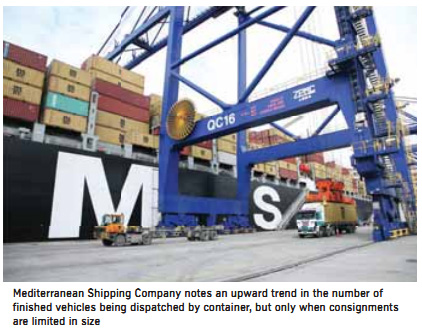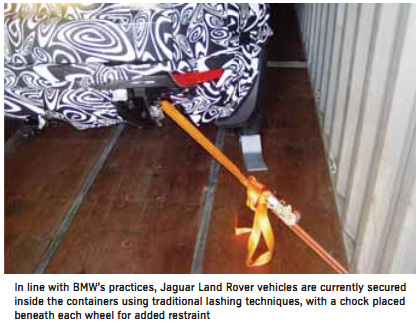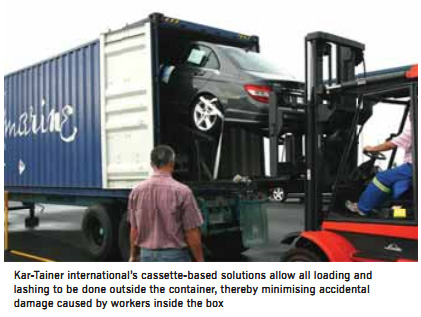While ro-ro may seem an automatic choice for mass transport of cars, there are many markets in which the speed, security and cost-effectiveness of travelling container class will always be an attraction.
While the great majority of the world’s vehicle exports move on ro-ro vessels, including pure car and truck carriers, there is a minor but nevertheless sizable volume that moves inside containers. Proponents of this mode point to lower costs, more frequent services to varied destinations, and higher protection against damage. Detractors point to increased handling, lower economies of scale, less specialised service and higher costs on a door-todoor basis.
Arguments on either side can be divisive and the hard statistics do not always exist to back up either claim. However, most industry experts seem to agree that the use of containers for vehicle shipping is rising, albeit from small numbers. Reasons for the ncrease include new markets opening up in areas where ro-ro service is patchy as well as declining freight rates in the container market because of lower trade volume and overcapacity. In markets where there are infrastructure limits, there is also the potential to use containers for inland legs of distribution by road or rail between ports and yards.
However, even container lines agree that exporting cars in a box will never replace or supplement the large share of ro-ro flows. Rather, containers will have their place on certain routes, with the reasons for choosing boxes varying by market requirements, speed, security and cost.
For those shipping cars by containers, another debate continues over the cost and operational benefits of using traditional lashing methods or specialised cassettes and racks. While several companies interviewed for this article have tended to favour traditional lashing, there are a variety of certified equipment providers, including Cronos, Trans-Rak, APL Logistics and Kar-tainer, claiming that their cassettes offer higher utilisation and lower damage rates.
Container lines note a rise in box movements Moshe Loberant, project manager at Maersk, the world’s leading container shipper, says there is definitely a growing use of containers to transport vehicles. In West Africa, the secondhand car market has used boxes extensively over the last decade, while in Latin America the number of imported vehicles in containers has risen in the last three years. Mediterranean Shipping Company (MSC) also notes an upward trend in the number of finished vehicles being dispatched by container. However, a company spokesperson suggests that this is the case only when consignments are limited in size.
Moshe Loberant, project manager at Maersk, the world’s leading container shipper, says there is definitely a growing use of containers to transport vehicles. In West Africa, the secondhand car market has used boxes extensively over the last decade, while in Latin America the number of imported vehicles in containers has risen in the last three years. Mediterranean Shipping Company (MSC) also notes an upward trend in the number of finished vehicles being dispatched by container. However, a company spokesperson suggests that this is the case only when consignments are limited in size.
Maersk itself has partly driven the rise in Latin America by using space available in non-operational refrigerated containers (NORs), which have typically been sent back empty from Asia to many destinations. Loberant believes it is a flow that will develop further. “This trend will most likely catch on in the Indian subcontinent too as automotive exports increase,” he says.
While NORs can only accommodate up to three units per container – versus four or five with some loading techniques – Loberant says that shipping lines can still offer competitive rates compared to the price of ro-ro since these backloads would otherwise be moving empty.
Captain Vivek Anand, general manager at NYK Line (India), also confirms the move towards greater containerisation, although NORs are not yet a significant feature for its services. He further emphasises that while the transport of cars by containers can be cheaper than traditional ro-ro services, manufacturers aren’t necessarily going to switch to containerisation en masse.
“Opting for one mode over the other depends on various factors,” he says, listing origin and destination, available trade routes, consignment volume, vehicle dimensions, port infrastructure, storage areas, parking space and security.
“Containers have an edge over ro-ro vessels where the distance between the manufacturing plant, origin or destination port and the consignee’s facility is long, thereby increasing the probability of damage to units due to multimodal transport handling,” Anand says.
Maersk’s Loberant says that another advantage of containers for some OEMs is the ability to ship premium cars in a protected, untouched environment. “The value proposition for small lot, high-end cars and diversified destinations is clear,” says Loberant, although it’s worth nothing that MSC and Maersk carry vehicles across the value spectrum.
Another important advantage for OEMs is the ability to send smaller volumes of vehicles to a wider variety of locations. “You can send smaller consignments of around 200 cars using containers, as opposed to the need to fill an entire ro-ro vessel. You don’t require special logistics facilities, plus container lines call at a larger portfolio of destinations,” Loberant adds.
Ro-ro will remain dominant
Captain Anand stresses that ro-ro shipping is still preferred in trade lanes where vehicle demand is high. “Although the cost of using containers may be cheaper and more competitive, ro-ro has the advantage of being able to transport huge volumes in a single call. It can also offer a better quality of vehicle delivery, since the product delivered by ro-ro is loaded, shipped and delivered in a regulated environment,” he says.
Moreover, Anand points out that each consignment is moved from the OEM’s plant in a ready, assembled and tested condition for ‘on road’ use. In contrast, the delivery of vehicles in containers in large volumes requires intensive handling, which may lead to minor damages that could be compounded by the lack of a repair facility at the point of destination.
Maersk predicts the costs of shipping vehicles by containers will drop further relative to ro-ro, but Loberant believes OEMs will still tend more towards ro-ro shipments, in part because of current supply chain designs. “The cost per unit for container lines is decreasing every year, whereas that for ro-ro is increasing. Having said that, ro-ro still offers great value to the automotive sector, plus the entire logistics supply chain is still geared to this mode of transport,” says Loberant.
He points out that container lines should not be seen as being in direct competition with ro-ro. “They work with very large shipments of finished vehicles, whereas we offer the ability to ship smaller consignments to a more diversified location portfolio. There is room for both in this market.”
 For niche markets, mainly
For niche markets, mainly
There are many companies that use containers to dispatch cars. India’s TCI Supply Chain Solutions, for example, uses containers to transport vehicles from the port of Chennai to Port Blair in the Andaman Islands.
“Because seaborne volumes are small – amounting to just 1,200 units annually - we can justify containers,” explains chief executive officer Jasjit Sethi.
A potential impetus to move more cars by containers in India would be to make use of the country’s large coastline, using sea to avoid deficiencies in road and rail infrastructure. However, Sethi believes that the current lack of volume makes the use of coastal shipping services to transport containerised cars difficult to justify. For similar reasons, TCI cannot justify investment in specialist racks and cassettes, relying instead on traditional lashing methods.
Even with ever-larger container vessels being deployed on deep-sea routes, Sethi doesn’t think it makes sense to use containers beyond niche markets.
“The problem is that you are not just paying for the finished vehicles placed within containers, but also for the envelope of air around them and lots of space, which will always make it costlier to use boxes than specialised ro-ro vessels,” he says.
Thomas Olsson, head of logistics in India for the logistics arm of the Volvo Group, agrees that boxes are used specifically when serving small volume, niche markets where there are limited ro-ro alternatives. Volvo Logistics has used containers to import vehicles to South Africa, South America and India, although it has yet to find return legs from the subcontinent. In other markets, containers would be out of the question.
“For the Chinese market, for example, where you might be importing a consignment of 20,000 cars, ro-ro would be the only viable means of doing so,” he says. “We use containers to take advantage of higher frequencies and also because container vessels give us access to a whole raft of arrival ports.”
Olsson adds that distance, volume or model type would not necessarily sway a decision to containerise units. “You have to look at the whole logistics chain, not just analyse a piece of it, when opting for one mode over another,” he stresses.
Depending on cost, the recipient of a consignment might prefer either to unload a vehicle at the port of arrival or on their own premises. And even with ro-ro, there are other costs involved, such as those linked to the use of a transit yard.
To secure vehicles within containers, Volvo Logistics makes use of both traditional lashing methods and also racks, with Olsson noting that Cronos Containers has developed boxes that are economically sound to use.
 BMW not lured by falling rates alone
BMW not lured by falling rates alone
BMW uses containers to specific markets where ro-ro shipments are not competitive because of the small volumes involved. “Our usage of containers is stable and we’re currently shipping less than 1% of our total outbound volumes via containers,” notes Matthias Wellbrock, head of worldwide vehicle distribution.
Despite falling rates in recent years, particularly on eastwest services, Wellbrock does not believe that this will result in it making a greater use of containerisation. “There are extra costs associated with container shipments and these are equally important,” he says. “For example, stuffing and stripping rates for containers have to be taken into account when assessing the overall financial viability of using boxes.”
However, Wellbrock accepts that containerisation makes sense for cars being shipped into smaller markets, where ro-ro is simply not competitive. Smaller ports can also be used to reach dealers more quickly and cheaply.
Comparing damage and theft rates, Wellbrock says there are only minimal cases of accessory thefts for either mode of transport, although he acknowledges that there are no statistics maintained for damage to vehicles shipped in boxes at BMW. But he believes that the damage rates are negligible.
Interestingly, despite the high value of most of its products, BMW tends to use traditional lashing techniques over racks, although both are used on occasions. Usually, just two vehicles are shipped per 40ft box.
Container are increasing for Jaguar Land Rover
Jaguar Land Rover (JLR) is also a small user of containers to ship vehicles, dispatching 1.1% of its total production by this method to 19 markets, although the number is increasing, according to Gareth Williams, JLR’s distribution manager.
The reasons for choosing containers over ro-ro vary from market to market. Sometimes containers are the only viable option, since the inbound port may not have suitable ro-ro facilities. Other ports are seen as more vulnerable, since storage might be uncovered. Some markets specifically request delivery by container.
“Overall, the number of finished vehicles we are shipping in containers is on the increase, reflecting the greater export to the 19 markets where boxes are preferred over ro-ro,” says Williams. “Nevertheless, the often-quoted financial advantage of using containers [such as being able] to make use of secondary ports to provide shorter landside movements to the dealer hasn’t stacked up to date in our experience.”
In line with BMW, JLR vehicles are currently secured inside the containers using traditional lashing techniques, with a chock placed beneath each wheel for added restraint. However, should vehicles get wider, Williams says that JLR will consider making using of racks, although it would depend on their availability, design and price.
JLR ships the majority of its container consignments in 40ft boxes, which can accommodate two vehicles. However, the company also ships single vehicles in 20ft boxes. “There would be absolutely no advantage at all to us to use larger, 45ft hi-cube boxes, since we couldn’t fit any more vehicles inside the containers,” says Williams.
As for damage rates, Williams believes the highly differing trading and handling conditions in each market make any viable comparison between container and ro-ro virtually impossible to make.
Williams notes that falling freight rates at container lines won’t necessarily lead JLR to shift more export consignments by boxes, although he admits that the company is always looking at competitive options if they are operationally viable. But he does not anticipate a significant shift from ro-ro to containers. One reason is that distributors in target markets might make specific requests not to do so; other reasons include the impacts on lead times; varying port and operational efficiency; available shipping options; differing clearance times at ports; the dimensions of some vehicles; damage risks; and difficulties in inspections and handovers.
Door-to-door container service
A number of companies are offering equipment that could make vehicle containerisation more interesting. APL Logistics has recently launched a flexible containerised transport service for vehicles called AutoDirect. The service delivers finished vehicles from factory or port, directly to the point of consumption with minimal handling in between.
The product is significant in that it uses a fit-on racking system that works with container equipment from any carrier – which is not always the case with other systems – and thus it’s a service with global reach (although APL has thus far only launched it in Asia).
“On a door-to-door basis, AutoDirect is cost-competitive with ro-ro,” claims Rinaldy Sudyatmiko, director of auto business development for APL Logistics. “More importantly, it allows for small quantities to be dispatched at shorter shipping intervals across a far wider option of vessel schedules.”
In terms of securing vehicles inside the containers, AutoDirect uses certified racking equipment that is collapsible, portable and returnable. The vehicles rest on these racks during transport and proper lashing is done to secure them. The service also includes helping customers to determine the best mix of container sizes for each shipment.
“The customised solution considers the specific mix of shapes, dimensions and numbers of the vehicles to be transported,” says Sudyatmiko. “The 40ft-high cube is the most common size AutoDirect has been using, but we are also able to deploy larger containers where it makes sense and equipment is available.”
 Methods of securement
Methods of securement
Despite the tendency among some companies to choose lashing over cassettes, many OEMs do not want personnel inside the confines of a container lashing down vehicles because of the risk of accidentally damaging cargo, says Richard Cox, CEO of Kar-Tainer International (KTI), whose cassette-based solutions allow all loading and lashing to be done outside the container.
“The actual method of lashing has been stipulated to us by such manufacturers as BMW, VW, Daimler and GM. In addition, following tests undertaken by the American Association of Railroads, we also went to purely aroundthe- wheel lashing, allowing vehicles to float on their ownsuspension. This has further improved vehicle quality during transit,” he says, noting that so-called traditional lashing methods compress the suspension of vehicles, which can be detrimental to quality over long haul routes.
“There has certainly been a global upsurge in the enquiry level for our systems,” says Cox. “The KTI solution is particularly strong in areas where the manufacturer is looking for an alternative to ro-ro, whereby a set number of a specific model is being shipping over a contracted period – implying a minimum period of preferably three years – and with overall volume of between 80 and 5,000 units per month.”
South Africa has traditionally been a strong export market for Kar-tainer. Most of the main manufacturers are present, but a huge imbalance in containers occurs, especially for European manufacturers. Containerised parts arrive from the north, with these boxes then needing to be repositioned. In these instances, Cox points to significant economic benefits for using cassettes, as the KTI solution allows 2-5 vehicles to be loaded per 40ft container, and he claims that the system aids lower damage ratios and more regular shipments.
“Our business model is based on a per-vehicle-shipped lease rate to the shipper or manufacturer, implying a three-year contract. As the systems are designed to be returned at the rate of ten to one, sending out 40 cars [in ten containers] with four cars per container, the equipment will be sent back with one container. This implies a minimal return cost on a per-vehiclebasis,” he says.
Although manufacturers spoken to for this article did not point to a significant difference in damage rates when using containers, Cox quotes one customer who reported damage rates reduced from 5% on ro-ro shipments to just 0.02% on KTI systems over a three-year period. He attributes this to less handling and quicker delivery, which helped to lower inventory costs.
“There will always be small volumes of cars going into remote areas where the return of KTI systems is not feasible. However, as markets are getting ever more quality conscious and just-in-time delivery becomes more important, the use of containers and cassette-based systems will become more prevalent,” he concludes

























![Global[1]](https://d3n5uof8vony13.cloudfront.net/Pictures/web/a/d/s/global1_726550.svgz)









